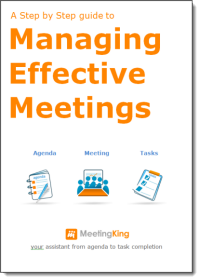Every meeting should have a purpose. Every meeting should aim to be a productive and valuable use of your time. Knowing how to effectively write meeting minutes will make sure that everyone feels that the meeting was time well spent.
In this article, we will discuss exactly what meeting minutes are, why structuring your meetings are important and outline some of our best tips for minute writing.
Meeting Minutes
Simply put, meeting minutes, also known as minutes of meeting (MoM), are notes that are taken in a meeting. They are used to record the key points discussed, the decisions made, future tasks, and log the individuals responsible for completing them.
Meeting minutes provide a structured and easy to comprehend record that captures the purpose and outcome of your meetings for future reference.
The Importance of Meeting Minutes
Taking meeting minutes at first glance might seem like a tedious and unnecessary task. However, minute writing saves time, determines ownership, provides both clarity and structure, and measures progress. You get out what you put in.
For example, after the meeting, some of your colleagues might have a dispute about what had been decided and who was responsible for certain tasks. They can settle this disagreement by checking the meeting minutes. The argument is dealt with and you do not need to hold another meeting to talk about the same things.
Tips for Writing Meeting Minutes Effectively
Taking meeting minutes is not about writing down everything that is being said. In fact, effective meeting minutes focus on essential points discussed in the meeting, they are well structured so it’s easy to find the information you are looking for, and you can effortlessly share them with others.
Let’s dive into our tried and tested minute-taking techniques that will make your next meeting more efficient, rewarding, and productive for your whole team!
1. Get Organized Before the Meeting
It is important to be prepared for a meeting in advance. You should be acquainted with the tools or software you are going to use to record meeting minutes. This way you can avoid any setbacks and save precious time to discuss things that really matter. Your meeting will be much more productive if you are focused on the reason you have all gathered together and everyone can add a meaningful contribution.
2. Take Advantage of Templates
Regardless of the type of meeting, your meeting minutes should include essential elements, like the date, the names of participants and the person taking the minutes, the agenda, etc. Other information depends on the formality and type of the meeting.
It is good practice to use standardized formats for writing meeting minutes, especially, if you have recurring meetings like weekly brainstorming sessions. These templates will provide consistency, save time, and help participants find specific sections they are interested in.
To ensure that you have an effective meeting minute format, simply include sections that are essential. If other topics are discussed during the meeting, you can always include them in the existing structure. If you need ideas, have a look at some meeting minutes templates created by MeetingKing.
3. Write Meeting Minutes While They Are Fresh
We live busy lives that are oversaturated with information and distractions. With so many things going on at any given time, it is essential to write minutes for the meeting as it happens, (rather than leaving this task for later). By taking notes throughout the session, you can avoid forgetting essential details that were discussed and have a clear and accurate record of the meeting.
4. State Facts and Maintain Neutrality
As the person responsible for writing meeting minutes, you should take the time to differentiate between personal points of view and indisputable facts; both are important! By recording only objective information, you will end up with useful meeting minutes that avoid any unnecessary conflicts among your team.
When taking meeting minutes, it helps to take a neutral position, and be cautious of your own biased disposition towards any specific participant in a group. Maintain professionalism and remove all irrelevant details that distract from the goals of the meeting.
5. List Actions and Assign Responsibilities
Meetings are organized with a goal in mind and to achieve that goal certain actions need to be completed. It’s much easier to get to the final destination if you know what kind of tasks need to be done and who will be responsible for them.
When writing meeting minutes, document all the necessary actions and people to whom they were assigned. If certain tasks need to be accomplished before a particular date, include the deadline as well. Such information not only provides the roadmap but also indicates those who are responsible for a successful landing.
6. Listen First, Summarize Later
If you want your meeting minutes to be efficient, clear, and helpful, make sure to finish listening to the whole point someone is making before writing anything down. This way you get all the necessary information and can record things accurately.
7. Attach Images
During meetings, it is common to draw certain points on boards or demonstrate them in graphs. If you want your meeting minutes to be particularly precise, you can take a photo of those notes.
Adding such a photo to the final document of the meeting minutes not only provides additional clarity but also prevents any ambiguity or misunderstandings.
8. Review Your Minutes
Meeting minutes provide an important record of decisions that were made, actions that must be completed, and who is responsible for their completion. Before sharing minutes with the rest of the team, ask someone to review them first. By proofreading the meeting minutes you make sure that all the details are clear and correct, and that they do not include any linguistic errors.
9. Send Minutes Promptly
After the meeting is over and your meeting minutes have been proofread, it is time to share them. Preferably, you should send them on the same day to all the participants, people who were not attending, and anyone else who needs to be aware of the decisions made during the meeting. This way, if there are some urgent tasks that should be completed, you make sure that everyone knows about them and meets deadlines.
In Summary
By using these simple and actionable tips for writing meeting minutes, you will have a clear, useful, and effective record of your meetings. You will also save time and prevent any misunderstandings as a result of messy, overloaded, or opinion-based notes.
If you want to supercharge your meetings with efficiency and productivity, give it a go for a FREE 30-day Meeting King trial. Our efficient meeting agenda and meeting minutes software helps you prepare the agenda, take meeting minutes, share documents, assign tasks, and much more.
___
The photo above is by Annie Spratt on Unsplash



